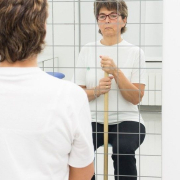Conservative or surgical treatment in adults? Two steps of therapy
Is there an alternative treatment to another in adults with scoliosis who suffer from back pain? The answer is no, simply because therapy is made up of several steps.
It just has been published by the scientific journal Annals of Translational Medicine the editorial comment of Isico “Symptomatic adult spinal deformity: implications for treatment“. A comment to another editorial, namely “Operative Versus Nonoperative Treatment for Adult Symptomatic Lumbar Scoliosis” which compared the treatment for adults with conservative asymptomatic scoliosis with that for surgical scoliosis.
Let’s start with a premise.
Lumbar scoliosis is particularly relevant for its significant correlation with back pain. There are two main common etiologies for this pattern, degenerative scoliosis and idiopathic. Degenerative curves, also called “de novo” scoliosis, derives from pathological changes at the level of the facet joints and discs in the lumbar spine. Usually, they are not very large but frequently very painful and rapidly progressive. The other type is idiopathic scoliosis appeared during growth that starts its progression in adulthood, usually depending on the size of the curve as previously stated. There is a further type of adult scoliosis called metabolic, which is less frequent.
The most common treatment for scoliosis patients with chronic low back pain, according to current practice, is the surgical one. This has the aim of both preventing progression and improving pain and quality of life. Unfortunately, surgery in such patients is associated with a relevant number of complications, so that it cannot be considered appropriate for every patient. Moreover, some patients don’t want to be operated.
“The study we considered – explains Dr Francesca di Felice, physician of Isico – presents a mixed design, with a randomized and an observational arm. In both arms, conservative treatment was compared to surgery. The general conclusions were driven from the observational arm, since in the randomized one the rate of crossover was dramatically high (64%): this led to similar results for both the approaches in the intent to treat analysis (ITT). For the observational arm, the success of surgery in improving pain and reducing disability was clearly higher than for the conservative approach as supported by the as-treated analysis. We think that this study raises a number of interesting points that should be discussed in the scientific community. The authors tried to apply the best possible design, which is the randomized control trial, but its results were not really informative for the high crossover rate. Hence our comment.”
The ITT is considered more conservative in such cases, and this could be an advantage in case some efficacy is equally demonstrated, but it also underestimates the side effects, and this is a significant shortcoming. We think it’s thus evident that the RCT design cannot be applied to the comparison of surgery and conservative treatment at least in this specific field of spine care. When patients have to face big issues like painful scoliosis, and/or very invasive treatments like fusion for scoliosis, they want to choose their treatment. Some of them want to be operated in case the conservative treatment is not effective, and others are scared of surgery and decide to avoid it.
Another limitation of the study is that there was no distinction between degenerative and idiopathic scoliosis. We know that the progression rate of the two is different, and also the association with pain. Degenerative scoliosis is more challenging for the conservative treatment, and focusing on this would have been more informative.
Furthermore, the most severe surgical complications for the patient compared to conservative exercise and brace treatment were not considered in the study.
“We are convinced that the choice between one treatment or another cannot be an alternative and thus dichotomous – concludes Dr Di Felice – both treatments must be considered as a step of therapy, if conservative treatment is not sufficient, it is necessary to resort to surgery.
Surgical complications are a big challenge in adult patients with scoliosis, so we cannot consider surgery as the best option for a problem that can affect QoL but is not life-threatening. We strongly believe that surgery can be a good option for very selected and motivated patients, but we need more data about the advantages of a surgery over the conservative treatment, and hopefully a further improvement of the surgical approach. On the other side, the conservative treatment protocol applied in this study doesn’t rely on the Guidelines on the conservative treatment currently available, we need an appropriately conservative approach to be studied, based on the current guidelines and evidence and managed by experts in the field.”

